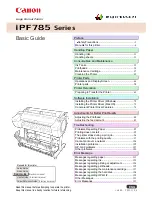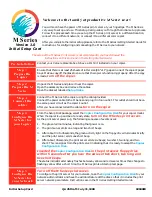
71
70
Router
Any device that forwards data along networks. Routers are located at gateways.
Shared Authentication
The access point sends an unencrypted challenge text string to any device attempting to communicate
with it. The device requesting authentication encrypts the challenge text and sends it back to the access
point. If the challenge text is encrypted correctly, the access point allows the requesting device to
authenticate. Both the unencrypted challenge and the encrypted challenge can be monitored; however,
this leaves the access point open to attack. Because of this weakness, shared key authentication can be
less secure than open authentication.
Signal Strength
A percentage (1 to 100) of the connection between the device and access point. If the signal strength is
0, there is no connection with the access point; 30 or less indicates you may be experiencing interference
or close to being out of access point range, and below 50, printing performance could be affected. To
improve the signal strength, try moving the printer closer to the access point and away from other radio
devices such as Bluetooth® wireless devices, microwave ovens, or 2.4-GHz cordless phones.
Speed or Transmit Rate
Sets the maximum rate of communication between the devices on thenetwork. It is also called transmit
rate.
SSID or Service Set Identifier
A unique identifier that must match for all nodes on a subnetwork to communicate with each other. It
consists of up to 32 characters (any printable character, including spaces). If using the space character, it
must be enclosed in quotation marks. It is case-sensitive.
Static Method
One of the available boot methods. Use static if your network uses fixed configuration. The IP address
remains the same every time the device connects to the network.
Subnet
A portion of a network that shares a common address component. On TCP/IP networks, subnets are all
devices with the same prefix. For example, all devices that start with 192.192.192 are part of the same
subnet. Dividing a network into subnets is useful for both security and performance reasons.
Subnet Mask
A mask is used to determine what subnet an IP address belongs to. Companies often
have ranges of IP addresses that can be described by one or more masks. For example, a mask of
255.255.255.0 allows variation in the last position only, because the first three positions are fixed.
TCP/IP
A way that two devices can transmit data between each other. TCP/IP(Transmission Control Protocol/
Internet Protocol) is generally the standard for transmitting data over a network.
TKIP (Temporal Key Integrity Protocol)
Changes the encryption keys regularly and has time limits before new keys are created. Changing the
key periodically provides additional security.
TLS (Transport Layer Security)
A cryptographic protocol that uses client-side and server-side certificates to authenticate users on the
Web. It can dynamically create user-based and session-based keys.
TTLS (Tunneled Transport Layer Security)
Provides certificate-based, server-side, mutual authentication of the client and network through an
encrypted channel (or tunnel). It can dynamically create user-based and session-based keys.
WEP or Wired Equivalent Privacy
A security protocol for wireless local area networks. WEP was designed to provide the same level of
security as that of a wired network, which is inherently more secure than a wireless network because
wired networks are easily protected against unauthorized access. Wireless networks use radio waves to
communicate and can be vulnerable to unauthorized users. WEP provides security by encrypting data
over radio waves so that it is protected as it is transmitted. However, it has been found that WEP is not
as secure as once believed
128 Bit / 64 Bit WEP Key
This is the 64 or 128 bit WEP key that must match other Nodes’ encryption keys to communicate:
10 hex characters for 64 bit (40 serspecifiedcharacters), or 26 hex characters for 128 bit (104 user-
specified characters). You must use the same key values for devices to
communicate with each other
WLAN or Wireless Local Area Network
A LAN that uses high-frequency radio waves to communicate between nodes, rather than telephone
wires, etc
WPA (Wi-Fi Protected Access)
A network security protocol that uses improved authentication and temporal keys. It was created to
address the weaknesses of WEP encryption.
WPA2(or IEEE 802.11i) :
A network security protocol with stronger encryption than WPA. It was created to address the
weaknesses of WEP encryption.
NOTE
If one part of a wireless network has WEP enabled, they all must have it enabled with the same key or they
cannot communicate.





































